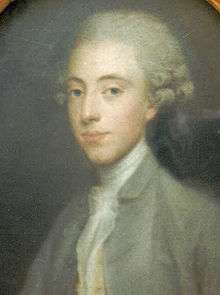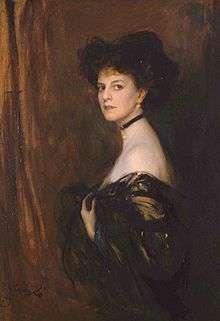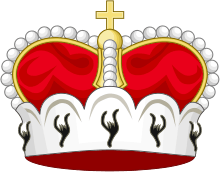Belgian nobility
.jpg)
The Belgian nobility comprises individuals and their families recognized by the Kingdom of Belgium as members of a class of persons officially enjoying hereditary privileges, which distinguished them from other persons and families.
Characteristics
The Belgian nobility is known to be mostly Roman Catholic, traditionalist, and royalist. Living in a bilingual Dutch and French-speaking country with a majority of Dutch-speaking people, historically the mother tongue of most is French, although many are also fluent in Dutch and other languages.
In the Kingdom of Belgium there were as of 2013 approximately 1,300 noble families, with some 20,000 members. The noble lineage of only approximately 400 families dates back to the 17th century or earlier. As Belgium is a democratic constitutional monarchy there are no legal privileges attached to bearing a noble title or to being a member of the aristocracy. Most noble surnames have the particle de (French for of/from) or the Dutch van as a prefix.
Most nobles in Belgium still belong to the elite of society. They sometimes own and manage companies, or have leading positions in business, banking, diplomacy, NGOs etc. Many of the older families still own (and reside in) important castles or country houses (see: Castles in Belgium).
Belgium is one of the few monarchies in the world in which hereditary ennoblement still occurs. Hereditary titles are conferred by letters patent, which are annually issued by the King of the Belgians.
Belgian citizens distinguished in business, politics, science, arts, sports, etc. or for extraordinary service to the Kingdom may receive noble status or noble titles. Recent examples include Ilya Prigogine (chemist, Nobel Laureate; made viscount in 1989), Paul Janssen (entrepreneur; made baron in 1990), Pierre Harmel (politician, Prime Minister of Belgium; made count in 1991), Dirk Frimout (astronaut; made viscount in 1992), Peter Piot (microbiologist; made baron in 1995), Eddy Merckx (cyclist; made baron in 1996), Patrick d'Udekem d'Acoz (royal father-in-law; made count in 1999), Toots Thielemans (musician; made baron in 2001), Frank De Winne (astronaut; made viscount in 2002), Jacques Rogge (President of the International Olympic Committee; made count in 2002), Gerard Mortier (opera director; made baron in 2007), Ingrid Daubechies (physicist and mathematician; made baroness in 2012) and Paul Buysse (manager; made count in 2014).
Structure of the Belgian nobility
Dukes in the Belgian nobility

Members of the following houses bear the title of Duke (Duc in French, Hertog in Dutch). The ducal title has never been granted outside the Royal Family in the Kingdom of Belgium. The origin of such titles for Belgian families thus pre-dates the current monarchy, having been conferred or recognised by sovereigns of other jurisdictions. Because it is usually borne only by the head of the family, with cadets taking princely or comital titles, "duke" is deemed higher than "prince" for these families (Arenberg, Croÿ, Ursel, Beaufort-Spontin, Looz-Corswarem).
Examples
- Arenberg,[1][2] princely Imperial count 1576, Imperial duke 1644, sovereign 1803-1811, mediatised; although all family members, male and female, are both duke and prince, Belgian recognition of "prince" and HSH for all members 1953, duke for Head of the House only, 1993
- Beaufort-Spontin,[3] 1746 Austrian Netherlands title of marquis with rank of prince by primogeniture, duke in 1782 and 1876, Imperial Count 1789; family members are Count/ess de Beaufort-Spontin, Head of the House is Duke and HSH
- Croÿ, Imperial prince 1486, 1594 and 1664, French duke 1598 and 1768; each member is prince/sse de Croÿ and HSH, while the Head is also the Duke
- Looz-Corswarem, 1734 Austrian Netherlands dukedom; mediatised, cadets are HSH prince/sse de Looz et Corswarem
- Ursel, Imperial Count 1638, Prince and Duke of Ursel and of Hoboken 1716 by the Austrian Netherlands, heraldic ducal crown and mantle authorized by Belgium 1884; each member is Count d'Ursel, Head is also Duke and Prince
Princes in the Belgian nobility

The title of Prince (Prince in French, Prins/Vorst in Dutch) title is not granted to new nobles, and may descend to one family member by male primogeniture, or to multiple male-line kin. Most families have a very old lineage (typically before the 15th century) and their ancestors often bore other titles before obtaining recognition of their princely title in Belgium. They were received on the occasion of royal court festivities by the King in the Salon Bleu of the Royal Palace of Brussels, henceforth being referred to as members of the Noblesse du Salon Bleu (Nobles of the Blue Salon). Some families obtained and still hold titles in other countries.
Royal Family
Members of the Royal family bear the title 'Prince of Belgium'. Sometimes a non-hereditary dynastic title is also granted. For example, the Crown Prince is traditionally granted the title of Duke of Brabant (Duc de Brabant/Hertog van Brabant), and King Albert II was called Prince of Liège (Prince de Liège/Prins van Luik) before his accession to the throne.
Examples
Most members of the families listed below have the right to be referred to in Belgian government documents as "Prince" or "Princess" in combination with their family name and most, though not all, are entitled to the style of Serene Highness.
- Swiatopelk-Czetwertynski, Prince Michel Czetwertynski, Prince Alexandre Czetwertynski, Prince Tinko Czetwertynski recognised in 2007
- Prince Carl of Sweden, Duke of Ostergotland (1911–2003), brother of Queen Astrid of the Belgians, having wed Countess Elsa von Rosen in 1937 in defiance of Swedish law, forfeited his Swedish succession rights and royal titles; received from his brother-in-law King Leopold III of Belgium title "Prince Bernadotte" for life in the Belgian nobility on the same date, Count/ess Bernadotte for his male-line descendants.
- Béthune-Hesdigneul, princely title descends by male primogeniture, cadets have no title
- Habsburg-Lorraine, Archdukes Rudolf (1950) and Carl Christian of Austria (1954), and their legitimate male-line descendants, were incorporated into Belgium's nobility as HSH Prince/ss de Habsburg-Lorraine in 1978 and 1983, respectively
- Ligne, Imperial Count 1549, Imperial prince 1601, mediatized 1803, 1923 Belgian recognition of title "Prince d'Amblise et d'Epinoy" by male primogeniture and of HH for each family member, each of whom also bears the princely title
- Lobkowicz, mediatized family of Bohemia whose 1624 Imperial princely title and HSH was recognized in Belgium for a member of the family who became a Belgian subject
- Merode, Imperial Count since 1622; Heads of the house bore the titles Marquis of Westerlo since 1626 and Prince of Rubempré and Everberg since the 18th century, title of Prince of Grimbergen inherited by primogeniture from Marie-Josephe de Mastaing-Oignies in 1842; each member is prince/sse de Merode since 1929. Famous is prince Emmanuel de Merode, director of the Virunga National Park.
- Réthy, Lilian Baels, second wife of King Leopold III, was declared Princesse de Réthy by her husband on the occasion of their marriage in 1941. She never bore the title of Queen and was addressed as HRH rather than Majesty. At the time of the announcement the King was under house arrest during the Nazi occupation of Belgium while his government was abroad, therefore the title was never formalised by letters patent nor gazetted except in a pastoral letter read throughout Belgian churches in December, 1941 by Cardinal van Roey.
- Riquet, Prince de Chimay in 1824 and Prince de Caraman 1856 by primogeniture; uniquely, since 1889 each male bears the title Prince de Caraman Chimay, while each female born in the family is a countess
- Princess Stéphanie de Windisch-Graetz (1909–2005), great-granddaughter of King Leopold II of Belgium. She was born into a mediatized Austrian family who were Imperial Counts since 1658, Imperial Princes since 1804, became a naturalised Belgian subject and was incorporated into the Belgian nobility with HSH
Marquises in the Belgian nobility
Only eleven families bear the title of Marquis. In most of these families, the title descends by masculine primogeniture.
Counts in the Belgian nobility
The titles Count of Hainault and Count of Flanders, historically associated with major provinces of what is now Belgium, are used as dynastic titles for members of the Belgian Royal Family. Bearers of these titles derive their royal rank at court from their place in the order of succession rather than from the precedence associated with the comital title.
Count is the highest-ranked title still granted by the Belgian monarch. There are approximately 90 families in Belgium at least one of whose members bears the title of count or countess. Sometimes the title descends to only one person by male primogeniture, sometimes to all members of the family in the male line, and occasionally to a specific branch of a noble family or only to the children of the head of the family. A famous family was the house of de Baillet-Latour. A living famous family is the House of Lannoy, family of Stephanie de Lannoy, current Hereditary Grand Duchess of Luxembourg.
Examples
An incomplete list of families bearing the comital title can be found on the list of noble families in Belgium.
Viscounts in the Belgian nobility
There are approximately 45 families in Belgium at least one of whose members bears the title of Viscount in Belgium (vicomte in French/Burggraaf in Dutch).
Examples
An incomplete list of families bearing the title of Viscount can be found on the list of noble families in Belgium.
Barons in the Belgian nobility
More than 300 individuals bear the title of Baron or Baroness. The title may descend either by masculine primogeniture or to all legitimate descendants in the male-line of the original title-holder.
Examples
Originally the house of udekem was ranked Baron, until the wedding of the Duke of Brabant with Mathilde d'Udekem d'Acoz, the house was promoted Count by royal Decree. Members of some families bearing the title of baron can be found on the list of noble families in Belgium.
Knights in the Belgian nobility
In Belgium there are roughly 200 knights (chevalier in French/Ridder in Dutch). The title descends by masculine primogeniture and there is no female equivalent. A knight's children bear no title per se.
Examples
An incomplete list of families bearing the title of knight can be found on the list of noble families in Belgium.
Noble families without a title
Noblemen without a title may be referred to as Écuyer (French for squire or shield bearer) or Jonkheer (Dutch, originally meaning 'young lord') which, like Honourable in British usage, is an honorific for the untitled children of British peers. It is used only as a written suffix to the full name in formal communications, replacing Mr. (Monsieur). The daughter of a person styled Jonkheer is Jonkvrouw, whereas the wife has no honorific and is usually titled Mevrouw ("Mrs."). Écuyer has no feminine equivalent for daughters or wives.
Most noble families in Belgium, as on the European continent generally, are untitled, and most female or cadet members of those families whose head is titled are untitled, although there are many exceptions. Most hereditary titles descend by masculine primogeniture. Other families, however, were recognised as noble (by Holy Roman Emperors, French kings, or other jurisdictions) prior to the creation of the Belgian kingdom and never received or assumed a title. Prior to the 19th century, nobles also occasionally relinquished their title voluntarily in order to "derogate", i.e., to engage in commercial enterprise forbidden by tradition or law to the titled nobility, as described above. Belgian monarchs have also raised individuals to noble status without conferring a title on them.
Examples
An incomplete list of families bearing the title of écuyer or jonkheer can be found on the list of noble families in Belgium.
Foreign noble families residing in Belgium
In addition to the families mentioned above, a number of noble families originated from outside Belgium, but have since obtained Belgian nationality after residing (sometimes for many generations) in Belgium. Most of these families have come from neighbouring European monarchies (France, the Netherlands, Germany) at various stages of history. These have usually (but not always) asked for equivalent nobility titles within the Kingdom of Belgium, which were typically granted.
A few noble families residing in Belgium emigrated from beyond the current European Union's borders, e.g. Russia or outside Europe, e.g. Korea or Japan. Many of these families formerly held titles of nobility in their country of origin, which have not always been converted into official Belgian nobility titles. Some families did not pursue a Belgian title because they hoped their stay in Belgium would be only temporary. This was the case for many Russian émigrés who came to Belgium in exile after the October Revolution.
Other families did not conversion either because of pride or because of cultural differences.
Many of these families have been in Belgium for so long, intermarrying with Belgian nobility, that they are more Belgian than foreign in blood (e.g. de Lobkowicz, de Radiguès de Chenneviere, Arrazola de Oñate).[4] Moreover, the family names have often been frenchified by adding particles such as de (e.g. Shin de Pyeongsan, originating from Korea's Pyeongsan Shin clan).
References
- M. Siegenbeek, "Levensbericht van P.C.G. baron de Coninck", in: Handelingen van de Maatschappij der Nederlandse Letterkunde, 1827
- Belgian Nobility on eupedia.com[5]
Further reading
Footnotes
| Wikimedia Commons has media related to Nobility of Belgium. |
- ↑ "Arenberg Stiftung - Arenberg Foundation - Fondation d'Arenberg - Arenberg Stichting". arenbergcenter.com. Archived from the original on 2007-03-29.
- ↑ Almanach de Gotha. Gotha, Germany: Justus Perthes. 1944. pp. 170, 190, 248, 354, 372, 390, 466–467, 484, 543.
- ↑ Ducal and princely families of Belgium: Beaufort-Spontin, Eupedia.com, retrieved 20 December 2009
- ↑ "Belgian nobility". Eupedia.
- ↑ This list is incomplete. The État présent de la noblesse is a more complete listing of noble families.
